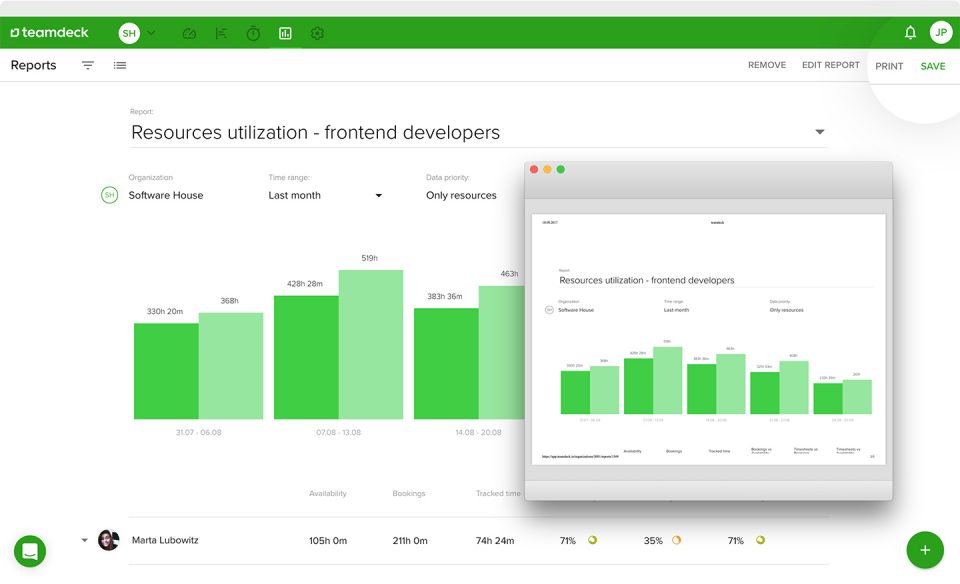资源规划员--如何挑选合适的资源规划员?
有效的资源规划对于各种规模的企业来说都是一个至关重要的目标,无论它们是在网上运营还是在传统行业中运营。鉴于需要进行资源规划的企业种类繁多,提供 "一刀切 "的建议具有挑战性......
目前,许多公司都在寻找成本优化的思路,以应对全球大流行病及其经济后果。在努力将人力资源成本降至最低时,团队决定 冻结招聘 或更有效地使用人力资源技术,以保持盈利并避免裁员。本着更好地利用现有技术的精神,我们想向您介绍企业如何通过以下方式削减业务成本 项目资源管理.
我们的建议适用于许多不同的行业,但同时为多个客户工作的公司(代理公司、咨询公司、软件公司)可能会发现这些建议特别有用。这是因为,当您同时处理多个项目时,规划和管理资源是非常具有挑战性的。
首先,让我们来定义资源管理。
在我们的 指南 项目资源管理我们将其定义为 最有效地利用有限的资源。 我们说的是哪种资源?当然是人,但也包括设备、房间、车辆或其他资源,这取决于您的业务性质。不过,在这篇博文中,我们将重点讨论人力资源管理。
最有效地利用资源意味着高效地利用资源、 将合适的人员分配到合适的项目中 (资源分配)分析团队工作,寻找优化机会。这些步骤对于削减业务成本至关重要,您将在接下来的几段中看到这一点。
使用 好 资源规划软件 将为您提供极大的帮助。当然,该应用程序不会为您完成所有工作,但它可以让您高效地完成工作,在此过程中节省时间和金钱。在本博文中,你将看到以下屏幕 团队甲板这是一款全球团队都在使用的应用程序。
发展 团队甲板作为一款完整的资源管理应用程序,我们经常与客户讨论资源管理对其预算的影响。
Apptension 是最早使用 Teamdeck 计划和管理员工工作的公司之一。Apptension 的财务和人事主管 Piotr Bandosz 告诉我们:
如果没有 Teamdeck,我们每月要浪费员工 $11,130 的时间来处理常见的管理问题。Teamdeck 帮助我们将这种浪费减少到 $1,249.50 美元,每月为我们节省 $9,880.50 美元。
Apptension 是一个由 50 人组成的团队,因此,如果您经营的是一家规模较大的公司,您可以期望节省更多费用。这怎么可能呢?让我们来详细了解一下--实施资源管理后如何省钱?
为什么 资源利用率 如此重要?简而言之:对雇主和员工都有好处。举个例子。等待完成任务的员工会给公司带来成本,但也可能 自暴自弃.另一方面,过度使用可能导致 员工职业倦怠 如果您为以下项目支付更多费用,雇主将承担额外费用 加时.其实很简单:有了最佳利用率,您就不会产生不必要的成本,您的团队成员也能享受到 平衡 团队工作量.
资源管理是保持良好资源利用率的关键。它要求你注意 资源规划 并将工作分配给可以承担更多任务的员工。当你看到团队成员的所有预订都在 资源日历这样,就能更容易地发现哪些人没有得到充分利用,哪些人被过度利用。

资源管理影响项目盈利能力的原因之一是,它可以帮助你挑选最合适的人员来完成特定任务。如果你的团队只有十个人,这似乎很容易。但如果你要管理 200 多名员工呢?
资源管理工具 像 Teamdeck 这样的软件可以让你对人才库有一个全面的了解。您可以看到谁可以加入新项目,还可以根据技能、工作资历或地点筛选团队成员。当最优秀的人才参与项目时,项目就更有可能取得成功。

不过,即使你的顶尖人才能够在规定的期限和预算内完成项目,结果也可能是勉强盈利。这一切都取决于您与客户商定的预算和计费方式。
例如,当您按小时(时间与材料)计费时,值得对团队的计费和非计费时间进行分析。 员工时间跟踪 是资源管理的一个重要方面。它可以让你在个人层面(如重新调整工作量)和项目甚至组织层面做出改进。

进入团队的 时间表报告 看看计费工时与非计费工时的细分情况。然后,花点时间思考如何改善这一比例,使其对自己有利。例如,您可能会注意到,您的项目团队在冗长的全体员工会议或项目报告等行政任务上花费了大量时间。你就会发现自己在哪里亏损了。
如何解决这个问题?改进公司内部流程是一个办法。另一个办法是以不同的方式处理未来的预算,例如,分配更大的缓冲资金。
沟通至关重要,尤其是对于那些转向远程工作的公司而言。如果你正处于这种情况,不妨看看我们的博文 远程团队的有效沟通.
然而,沟通也确实会令人沮丧和耗费时间。举个例子?想象一下,你是一个团队的负责人,与你的同事进行了如下对话:
还有一个例子是,人们不确定自己一天中应该专注于哪些工作。这听起来可能令人惊讶,但这种情况并不罕见,尤其是对于一周内支持多个项目的职位(如插图画家、DevOps 专家)。
这看似天真无邪,但类似的对话会占用员工数周的时间。如果能省去这些来回奔波的时间,转而使用高效的系统来规划和管理工作或休假时间,岂不美哉?这就是资源管理工具的用武之地。

当您的团队致力于资源管理时,员工就可以轻松查看他们未来几天的优先事项。假期津贴和申请也能以无摩擦的方式处理。作为公司,您可以节省开支,而您的团队成员则可以专注于与他们相关的交流。
您是否曾经经历过昂贵的招聘过程,但最终雇用的员工并没有那么多工作要做?又或者,您获得了几个项目,却发现自己没有足够的 能力 而不得不以额外费用雇用自由职业者或外包团队?如果进行了资源预测,这两种情况都可以避免。这意味着,您要尝试预测何时需要多少资源。
资源管理如何帮助您 人力资源预测?
首先,您的经理可以更好地了解团队的能力和当前工作量,从而可以相应地规划生产流水线。其次,您可以分析团队工时表中的历史数据,找出规律。例如,许多机构都有季节性的资源需求:有几个月的工作量比较大。提前了解这一点,就能为资源短缺做好准备,启动招聘流程或与外包公司谈判达成更好的协议。这样,您就能优化支出,更好地规划财务。
面对危机,您的第一反应可能是限制开支。当你迫切希望节省开支时,投资资源管理应用程序似乎有悖常理,对吗?实际上,只要您的管理团队致力于有效地 资源规划和管理因此,投资回报率应该很高。
以 Apptension 公司为例,据该公司估计,由于使用了 Teamdeck,他们每月可节省 $10k 的费用。他们花了多少钱呢?一个人的许可证费用为 $3.99,因此一个 50 人的团队每月需要支付 $199.50。正如您所看到的,这只是他们通过有效管理资源而节省的一小部分。
想知道贵公司的投资回报如何?我们来聊聊吧! 与 Aniela 预约通话她将与您讨论您的资源管理需求,并向您展示 Teamdeck 如何帮助您降低业务成本。